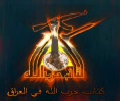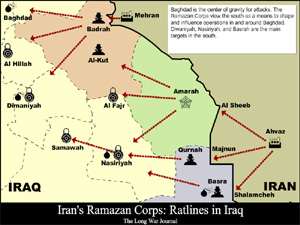|
|
|
Hezbollah Brigades’ logo is nearly identical to that of Lebanese Hezbollah. |
US and Iraqi forces continue to keep pressure on the Iranian-backed Hezbollah Brigades operating in the Iraqi capital of Baghdad. Six members of the group have been captured and one has been killed over the past three days.
Coalition forces, likely the special operations hunter-killer teams of Task Force 88, conducted two raids in Baghdad’s Karadah district. One Hezbollah Brigades operative was killed while resisting arrest, while two more members of a special “operations cell” were captured during a raid targeting the cell leader.
Four more members of the Hezbollah Brigade were captured during separate raids in Baghdad’s Adhamiyah district and south of Sadr City on Dec. 1.
The Hezbollah Brigades have been hit hard over the past three weeks. US and Iraqi forces have killed three members of the terror group and captured eighteen more during raids in and around Baghdad over the past three weeks.
The Hezbollah Brigades, or Kata’ib Hezbollah, has been active in and around Baghdad for more than a year. The terror group has increased its profile by conducting attacks against US and Iraqi forces using the deadly explosively formed penetrator land mines and improvised rocket-assisted mortars, which have been described as flying improvised explosive devices. The Hezbollah Brigades has posted videos of these attacks on the Internet.
The terror group is an offshoot of Iranian-trained Special Groups, the US military said last summer. Hezbollah Brigades receives funding, training, logistics, guidance, and material support from Iran’s Qods Force.
Background on Iran’s backing of the Shia terror groups
|
Flash Presentation on the Ramazan Corps and the Iranian Ratlines into Iraq. Click the map to view. A Flash Player is required to view, click to download. |
Qods Force has supported various Shia militias and terror groups inside Iraq, including the Mahdi Army, helping to build the groups along the same lines as Lebanese Hezbollah. Iran denies the charges, but captive Shia terrorists admit to being recruited by Iranian agents and then transported into Iran for training.
Iran established the Ramazan Corps immediately after the fall of Saddam Hussein’s regime to direct operations inside Iraq. The US military says Iran and Lebanese Hezbollah have helped establish, fund, train, and arm, and have provided operational support for Shia terror groups such as the Hezbollah Brigades and the League of the Righteous. The US military refers to these groups as well as the Iranian-backed elements of the Mahdi Army as the “Special Groups.” These groups train in camps inside Iran.
US and Iraqi forces have captured several high-level Qods Force officers inside Iraq since late 2006. Among those captured are Mahmud Farhadi, one of the three Iranian regional commanders in the Ramazan Corps; Ali Mussa Daqduq, a senior Lebanese Hezbollah operative; Qais Qazali, the leader of the Qazali Network; and Azhar al Dulaimi, one of Qazali’s senior tactical commanders. The US has imposed sanctions on Major General Ahmad Foruzandeh, the former Qods Force commander, and Abdul Reza Shahlai, a deputy commander in Iran’s Qods Force, for backing Shia terror groups inside Iraq.
US military officers believe Iran is ramping up its operations inside Iraq after its surrogates suffered a major defeat at the hands of the Iraqi military during the spring and summer of 2008. Iraqi troops went on the offensive against the Mahdi Army and other Iranian-backed terror groups in Baghdad and central and southern Iraq. More than 2,000 Mahdi Army members were killed and thousands more were wounded. The operation forced Muqtada al Sadr to agree to a cease-fire and disband the Mahdi Army.
Recently, the US military shifted its tone on the Mahdi Army, and has begun to refer to the group as a ‘militia insurgency group.’ Previously the US military took a more conciliatory tone with the Mahdi Army in an effort to coax members in reconciling with the government.
Sadr has threatened to form a new unit, called the “Brigade of the Promised Day,” to target Coalition forces. But Lieutenant General Lloyd Austin, the operational commander of US ground forces in Iraq, largely dismissed the threat when asked about the purported new Shia terror group.
“While certainly we’ve heard talk of this issue, we’ve not seen any tangible evidence of these brigades operating in and around the countryside,” Austin said in a Baghdad press briefing on Nov. 3.”If and when we do find that and if there is an armed element that conducts operations against the Iraqi Security Forces, the Government of Iraq, or the coalition forces, we’ll deal with those forces just as we’ve done with any criminal element that we’ve faced in the past.”










3 Comments
Just wondering what happens to all these “arrested, taken into custody” bad guys? Do they end up in limbo land, or are they processed then some days, months, etc. let go back into freedom?
Who watches over them when captured? For how long till they are transferred to another group of “watchers?”
Good work troops, keep eliminating the Iranian agents that are sent to sow chaos.
How similar is the flying IED –
Based on the images of the launchers used in the April 28 attacks [see slideshow], the IRAM looks to be a large canister, perhaps a propane or fuel tank, filled with explosives and propelled by 107mm rocket booster. These types of improvised weapons — essentially flying IEDs — would have a short range and would be highly inaccurate.
– to the anti-civilian propane tank bombs used by Columbian Communists?